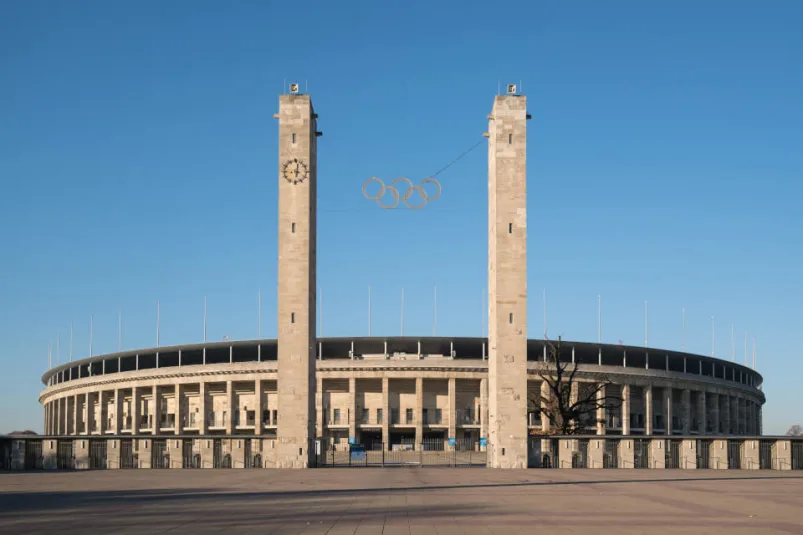Berlin's Olympic Stadium (1936) - A Famous Nazi Monument

A project aborted by the outbreak of the First World War and then shaped by Hitler, the Berlin Olympic Stadium was the cradle of the "Olympic Games of Shame" in 1936. This monument, typical of Nazi architecture and oversized for its time, was to serve the propaganda of the Third Reich and impress other nations!
Whether you are an architecture lover, a history lover or simply curious, (re)discover the history of this emblematic stadium.
German Stadium (1913) - a false start!
In 1912, the International Olympic Committee (IOC) designated Berlin as host for the 1916 Olympic Games. In response to this honour, the city of Berlin built a 30,000-seat stadium on the site of a former racecourse (the original ticket offices can still be seen), which was later enlarged to 64,000 seats. Inaugurated on 8 June 1913, this stadium will never host the Games - cancelled due to the outbreak of the First World War!
The stadium was then renamed the "Deutsches Stadion" (German Stadium). It was also known as the Grunewald-Stadion because of its geographical location.
Olympiastadion (1936) - German victory but Nazi defeat
In 1931, when the IOC decided to reallocate the hosting of the Olympic Games to Berlin, it was decided to restore and simply reuse the same structure already supposed to host the 1916 Games. However, not everything happened so simply!
Adolf Hitler, who became Chancellor of Germany in 1933, saw the Olympic Games as a springboard for Germany's supremacy. With a view to establishing his Nazi ideology and providing "proof" of the superiority of the Aryan race to the whole world, he took advantage of the international influence of this event to intensify his propaganda.
To this end, Hitler ordered the architect Werner March (already the architect of the 1916 stadium) to draw up the plans for the new and grandiose "Olympiastadion"! Forty-two million marks were spent to build a stadium with 86,000 to 110,000 seats. Inspired by the Colosseum in Rome, the stadium is a major monument designed to show the power and supremacy of Germany to the rest of the world, not only in sporting terms, but also in the way its buildings and architecture dominate the landscape.

Berlin, Olympic Stadium, 1936 (Wikimedia Commons, Bundesarchiv, Bild 183-R82532 / CC-BY-SA 3.0)
The main entrance, known as the Olympic Gate, is framed by two monumental 35-metre high towers between which the Olympic rings are suspended.
The Olympic Games are all the more popular because they coincide with the birth of television: more than 160,000 people will follow the highlights of the Games on the small screen. When the Chancellor appears, 100,000 arms will be raised to the tribune of honour to greet him.
However, things did not turn out as planned: it was neither Germany's pomp and circumstance nor the performance of the German team (which finished first in the Games) that left a lasting impression, but rather the four gold medals won by the legendary athlete Jesse Owens and the anger of Hitler leaving the venue to avoid saluting the black American champion. If Hitler thought he had planned everything to make the games work to his advantage, it was without counting on the extraordinary performance of the American athlete who contradicted Hitler's statements about the so-called "inferior" races.
The stadium today
The entire stadium was renovated in 2004, in order to return to the original architecture of the time and make it suitable for more modern use. It was in this stadium that the final of the 2006 Football World Cup took place.
Finally, it is the historic home of the Hertha BSC Berlin football club. However, the club is looking to build another football stadium in Berlin by 2025 ! It will be interesting to see what will become of the stadium, given its tumultuous history.
You can visit the Berlin Olympic Stadium independently (8€) or as part of a guided tour (12€).
Practical information
Adress: Olympischer Platz 3, 14053 Berlin.
Price: 8-12€
Source of image: Thomas Wolf, www.foto-tw.de, Olympiastadion Berlin 2015, CC BY-SA 3.0 DE

Raphaëlle Radermecker
Author
With a curious personality and a passion for well-chosen words, writing and discovery are my two passions. Berlin intrigues and fascinates me, with its cultural and artistic richness, its modernity and its ability to constantly renew itself.